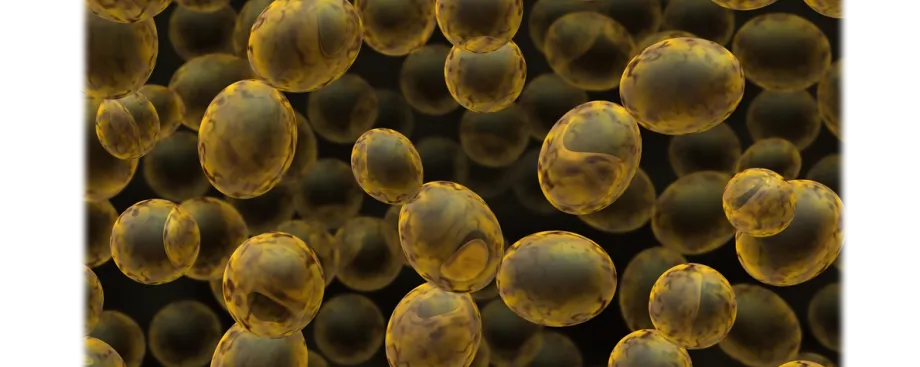
Graphic by Knorre, Shutterstock: A new technique allowed researchers to track genetic mutations within individual yeast "families."
Stanford Medicine News Center - February 25th, 2015 - by Krista Conger
Bakers and beer brewers welcome the gentle, gradual bubbling that occurs when yeast is stirred into warm, sugary liquid. However, this soothing sign that all is well in the kitchen or brewery belies a pitched battle waged just under the murky surface.
There, individual yeast “families,” or clones, compete for ever-more-scarce resources as their numbers grow. Those that develop mutations that give them an edge over the competition can go on to generate more progeny than their peers, effectively crowding them out altogether.
This means little to those of us who simply want a fresh loaf of bread or a tasty lager. But understanding how this type of clonal competition and evolution plays out on a large scale could have important implications for researchers and clinicians trying to understand how a bacterium or virus spreads and changes during an infection, or how cancer cells evolve as a tumor grows or even rebounds from cancer treatment.
Now, researchers at Stanford University have devised a way to label and track the descendants of about 500,000 individual yeast cells for hundreds of generations. The technique allowed the researchers to track the rise and fall of specific families over time in the teeming underworld of yeast-population dynamics.
Surprisingly, they found that about as many as 1 percent of naturally occurring mutations confer a fitness benefit of some kind. But not all mutations are equal.
“At first, we saw large numbers of mutations that each provided a relatively modest fitness benefit to individual families but that together increased the overall fitness of the population as a whole,” said Gavin Sherlock, PhD, an associate professor of genetics. “Later, we began to see more rare mutations with a larger fitness benefit; families with these mutations tend to then drive to extinction others with less advantageous mutations.” In other words, after a slow and steady accumulation of “OK” mutations in the population, the big guns come out.
Tagging cells
A paper describing the results of the research was published Feb. 25 in Nature. Sherlock is the senior author, and former postdoctoral scholar Sasha Levy, PhD, and postdoctoral scholar Jamie Blundell, PhD, share lead authorship. Blundell is a shared postdoctoral scholar in the laboratories of Dmitri Petrov, PhD, professor of biology, and Daniel Fisher, PhD, professor of applied physics. Levy is now an assistant professor of physical and quantitative biology at Stony Brook University in New York.
The researchers devised a way to insert specific short, unique sequences of DNA — about 20 nucleotides — into individual yeast cells. Each cell is tagged with a single one of these sequences, which functions as a kind of unique, heritable genetic barcode that can be used to track the fate of that cell and all its progeny.
In this way, the researchers tagged about 500,000 individual cells in a single yeast population, and then allowed the population to grow. Once every eight generations, the researchers used high-throughput sequencing to estimate the reproductive success of each yeast family. They continued these regular check-ins over about 168 generations to generate a dynamic picture of the rise and fall of yeast dynasties.
Dividing yeast naturally accumulate mutations as they repeatedly copy their DNA. Some of these mutations may allow cells to gobble up the sugar in the broth more quickly than others, or perhaps give them an extra push to squeeze in just one more cell division than their competitors.
Top 100 beneficial mutations
“Within 168 generations, somewhere between 15,000 and 20,000 families showed an increase in numbers greater than would be expected by chance,” said Sherlock. “These families likely benefited from the occurrence of beneficial mutations. So, in every generation, about 1 out of every 100,000 cells develops a beneficial mutation.”
The researchers found that by about 112 generations, most of the population’s growth is being driven by the top 100 beneficial mutations; by generation 132, the number of members from families with less-advantageous mutations have waned to just a small proportion of the total.
Sherlock noted that yeast naturally accumulate mutations at a frequency of about 1 in every 1,000 cell divisions — or put another way, 1 cell out of every 1,000 gets a mutation of some sort every generation. These findings suggest that about 1 percent of these random mutations confer a fitness benefit.
The analysis was possible only because of the recent development of high-throughput sequencing technologies that allowed the researchers to trace even families present at ratios as low as 1 member per every 100,000 cells in the colony.
“The sequencing capacity has only been available during the past three or four years,” said Sherlock. “Each experiment required about 15 time points, and each time point required about 50 million to 80 million sequencing reads, which is equivalent to sequencing the human genome once.”
Sequencing entire genomes
The researchers are now beginning to sequence the entire genomes of the most successful families to identify the specific mutations involved. However, they note that the identity of beneficial mutations will vary depending on the experimental conditions in which the yeast are permitted to evolve. Yeast challenged by other types of stress, such as temperature changes, are likely to have different mutations selected than those in this experiment that were competing for scarce supplies of sugar.
Monitoring cells present only in very small numbers allowed the researchers to see the full spectrum of growth and extinction rates in the population.
“Just because a family goes extinct doesn’t mean it couldn’t have been important,” said Sherlock. “Even those with mildly beneficial mutations play a role, perhaps by preventing families with even less beneficial mutations from increasing in size.”
Graduate student Sandeep Venkataram is the other Stanford author.
The research was funded by the National Institutes of Health (grantsR01HG003328, 5T32HG4417 and R25GM067110), the National Science Foundation, Stanford Bio-X, the Betty Moore Foundation and the Louis and Beatrice Laufer Center.
Information about Stanford’s Department of Genetics, which also supported the work, is available at http://genetics.stanford.edu.



